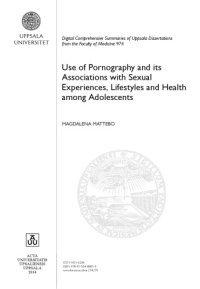
Ebook: Use of Pornography and its Associations with Sexual Experiences, Lifestyles and Health among Adolescents
Author: Magdalena Mattebo
- Tags: Sweden Adolescents Pornography Sexuality Sexual experiences Lifestyles Health
- Series: Digital Comprehensive Summaries of Uppsala Dissertations from the Faculty of Medicine
- Year: 2014
- Publisher: Uppsala Universitet
- City: Uppsala, Sverige
- Language: English
- pdf
The overall aim of this thesis was to investigate pornography consumption and its relation to sexual experiences, lifestyles, health and perceptions of sexuality and pornography. One qualitative study (focus group discussions) and one prospective longitudinal quantitative study (baseline and follow-up questionnaires) are included.
The core category emerging from the focus group discussions, among personnel working with adolescents, was “Conflicting messages about sexuality”. The participants’ stated that the message conveyed by pornography was contradictory to the message conveyed by national public health goals and laws. A professional approach was emphasized, and adequate methods and knowledge to improve sexuality and relationship education were requested (I).
Participants at baseline in 2011 were 477 boys and 400 girls, aged 16 years. Almost all boys (96%) and 54% of the girls had watched pornography. The boys were categorized into frequent users (daily), average users (every week or a few times every month) and nonfrequent users (a few times a year, seldom or never) of pornography. A higher proportion of frequent users reported experience of sex with friends, the use of alcohol, a sedentary lifestyle, peer-relationship problems and obesity. One-third watched more pornography than they actually wanted to (II).
There were few differences between pornography-consuming girls and boys regarding fantasies about sexual acts, attempted sexual acts inspired by pornography and perceptions of pornography. Predictors for being sexually experienced included: being a girl, attending a vocational high school programme, stating that boys and girls are equally interested in sex, and having a positive perception of pornography. Boys were generally more positive towards pornography than girls (III).
Participants at follow-up in 2013 were 224 boys (47%) and 238 girls (60%). Being male, attending a vocational high school programme and being a frequent user of pornography at baseline predicted frequent use at follow-up. Frequent use of pornography at baseline predicted psychosomatic symptoms to a higher extent at follow-up than depressive symptoms (IV).
In conclusion, pornography has become a part of everyday life for many adolescents. Frequent users of pornography were mainly boys, and there were minor differences in sexual experiences between the male consumption groups. Frequent use was associated with lifestyle problems, such as the use of alcohol and a sedentary lifestyle to a higher extent than with sexual experiences and physical symptoms. In the longitudinal analyses frequent use of pornography was more associated to psychosomatic symptoms compared with depressive symptoms. Access to pornography will presumably remain unrestrained. It is therefore important to offer adolescents arenas for discussing pornography in order to counterbalance the fictional world presented in pornography, increase awareness regarding the stereotyped gender roles in pornography and address unhealthy lifestyles and ill health among adolescents.
The core category emerging from the focus group discussions, among personnel working with adolescents, was “Conflicting messages about sexuality”. The participants’ stated that the message conveyed by pornography was contradictory to the message conveyed by national public health goals and laws. A professional approach was emphasized, and adequate methods and knowledge to improve sexuality and relationship education were requested (I).
Participants at baseline in 2011 were 477 boys and 400 girls, aged 16 years. Almost all boys (96%) and 54% of the girls had watched pornography. The boys were categorized into frequent users (daily), average users (every week or a few times every month) and nonfrequent users (a few times a year, seldom or never) of pornography. A higher proportion of frequent users reported experience of sex with friends, the use of alcohol, a sedentary lifestyle, peer-relationship problems and obesity. One-third watched more pornography than they actually wanted to (II).
There were few differences between pornography-consuming girls and boys regarding fantasies about sexual acts, attempted sexual acts inspired by pornography and perceptions of pornography. Predictors for being sexually experienced included: being a girl, attending a vocational high school programme, stating that boys and girls are equally interested in sex, and having a positive perception of pornography. Boys were generally more positive towards pornography than girls (III).
Participants at follow-up in 2013 were 224 boys (47%) and 238 girls (60%). Being male, attending a vocational high school programme and being a frequent user of pornography at baseline predicted frequent use at follow-up. Frequent use of pornography at baseline predicted psychosomatic symptoms to a higher extent at follow-up than depressive symptoms (IV).
In conclusion, pornography has become a part of everyday life for many adolescents. Frequent users of pornography were mainly boys, and there were minor differences in sexual experiences between the male consumption groups. Frequent use was associated with lifestyle problems, such as the use of alcohol and a sedentary lifestyle to a higher extent than with sexual experiences and physical symptoms. In the longitudinal analyses frequent use of pornography was more associated to psychosomatic symptoms compared with depressive symptoms. Access to pornography will presumably remain unrestrained. It is therefore important to offer adolescents arenas for discussing pornography in order to counterbalance the fictional world presented in pornography, increase awareness regarding the stereotyped gender roles in pornography and address unhealthy lifestyles and ill health among adolescents.
Download the book Use of Pornography and its Associations with Sexual Experiences, Lifestyles and Health among Adolescents for free or read online
Continue reading on any device:

Last viewed books
Related books
{related-news}
Comments (0)